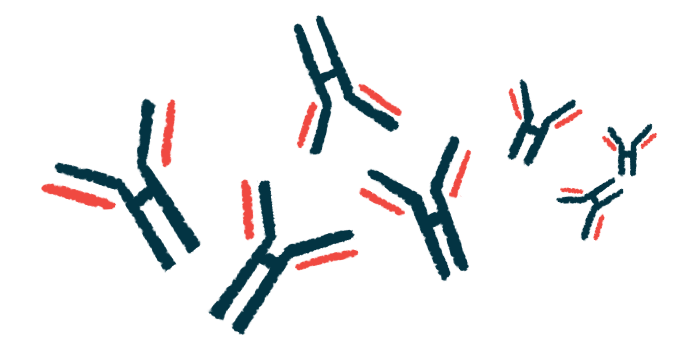Biomarker found for potential new disorder that’s been labeled as MS
Findings could pave way for more targeted treatments, researchers say

An antibody biomarker may help to distinguish people with a disease that resembles multiple sclerosis (MS), but may actually be its own clinical disorder, according to a new study.
The biomarker was present in about 1% of MS patients and in 6% of those with a related demyelinating condition called neuromyelitis optica spectrum disorder (NMOSD).
“By distinguishing between myelin-destroying autoimmune diseases that were previously all called MS, we’re taking an important step towards a better understanding of the causes of these illnesses and towards individualized treatments,” Anne-Katrin Pröbstel, MD, a professor at the University of Basel and co-author of the study, said in a university news story.
The study, “Immunoglobulin A Antibodies Against Myelin Oligodendrocyte Glycoprotein in a Subgroup of Patients With Central Nervous System Demyelination,” was published in JAMA Neurology.
‘MS’ used to describe disease where inflammation causes CNS myelin damage
MS is characterized by inflammation in the central nervous system (CNS, comprising the brain and spinal cord) that causes damage to the myelin sheath, a fatty covering around nerve fibers that helps them send electrical signals. This inflammatory myelin damage disrupts nerve signaling, ultimately leading to disease symptoms.
For most of modern medical history, the term “multiple sclerosis” has been broadly used to describe any disease where inflammation causes myelin damage in the CNS. However, in recent years, researchers have begun to more specifically identify inflammatory CNS diseases that are better recognized as their own separate clinical entity.
As an example, NMOSD was long considered to be a subtype of MS but it is now considered a separate disease. NMOSD is defined by the presence of a specific type of antibody, called immunoglobulin G or IgG, which targets a brain protein called AQP4 to drive disease.
Identifying NMOSD as its own disease has helped clinicians to better understand the underlying disease processes, which in turn has paved the way for more targeted treatment approaches.
Another IgG antibody targeting the protein MOG (myelin oligodendrocyte glycoprotein) has also been found to be a marker of a distinct clinical entity, called MOG antibody disease or MOGAD, which was previously considered a subtype of MS or NMOSD.
By distinguishing between myelin-destroying autoimmune diseases that were previously all called MS, we’re taking an important step towards a better understanding of the causes of these illnesses and towards individualized treatments.
Scientists study immunoglobulin A antibody
In this study, scientists turned their attention to another type of antibody called immunoglobulin A or IgA. Whereas IgG antibodies are produced throughout the body, IgA are mainly made in mucus membranes.
“In contrast to IgG, which is known for its proinflammatory role … the pathogenic [disease-causing] potential of IgA is debated,” the researchers wrote.
The scientists conducted an analysis of data from 1,339 people with inflammatory demyelinating CNS diseases. Most of these individuals had been diagnosed with MS, and some with NMOSD or MOGAD.
The scientists found 18 patients who were positive for IgA antibodies targeting the MOG protein (termed MOG-IgA). These 18 patients were negative for IgG antibodies targeting either MOG (which defines MOGAD) or AQP4 (which defines NMOSD), and IgA antibodies targeting MOG were not found in samples from people without CNS disease who were tested as controls.
Among these 18 patients, 10 had been diagnosed with MS, three with NMOSD, and five with other inflammatory CNS diseases.
The researchers found that these 18 patients with IgA against MOG tended to have distinct clinical features compared with other patients with MS, NMOSD, and/or MOGAD.
For example, most of these patients had inflammatory damage in the spinal cord and/or brainstem, which was less common in patients who did not have these antibodies. Additionally, fewer MOG-IgA-positive patients had optic neuritis (inflammation of the nerves that connect the eyes to the brain).
The researchers also noted that less than half of patients with MOG-IgA who had been diagnosed with MS had oligoclonal bands, a disease marker that was present in more than 90% of patients with MS who did not have these antibodies.
Collectively, these data suggest that MOG-IgA may be a marker of a separate clinical entity that has previously been grouped in with MS and other inflammatory CNS disorders.
“The distinct clinical syndrome in patients seropositive for isolated MOG-IgA … suggests that IgA may have a pathogenic role in CNS inflammation,” the researchers wrote.
They stressed that this study was limited by its retrospective nature, and the small number of MOG-IgA-positive patients made it difficult to conduct robust statistical analyses. They called for further investigation into the potential utility of MOG-IgA as a disease biomarker.







